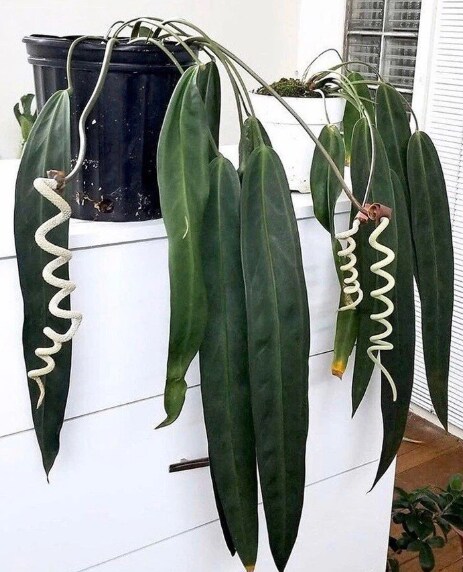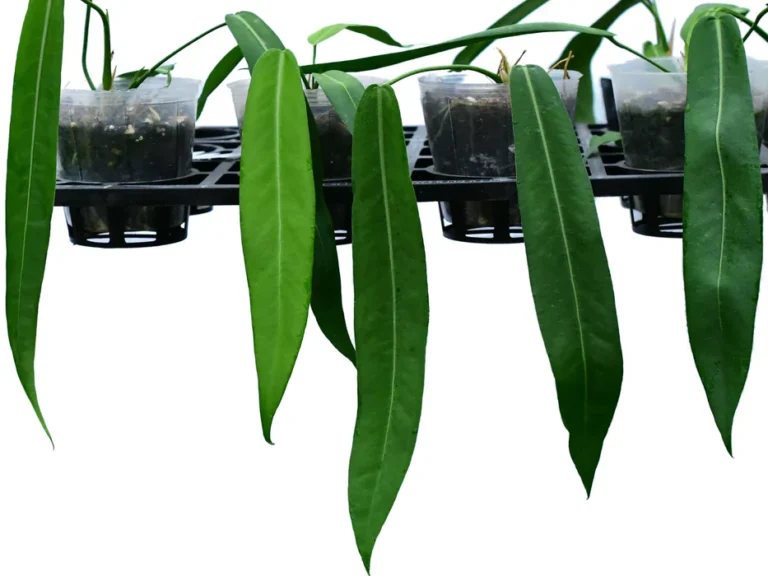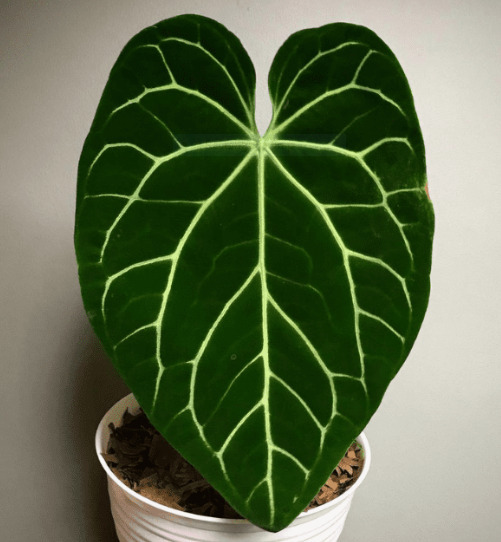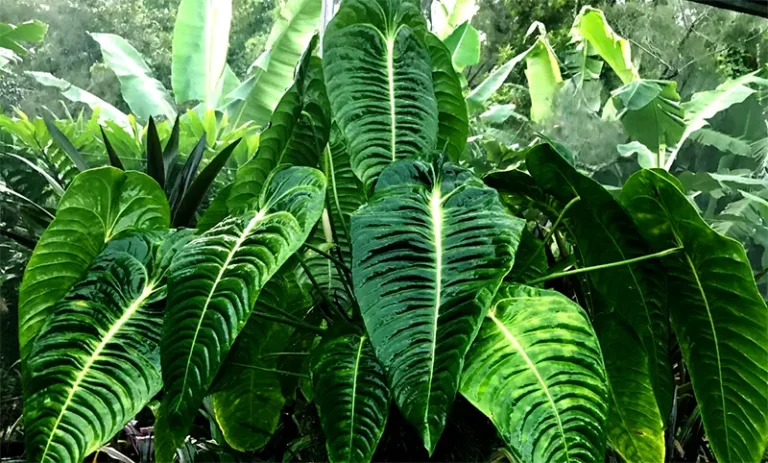Anthurium Papillilaminum: Description, Care, and Propagation
The classic ‘unicorn’ Anthurium Paillilaminum is a popular tropical houseplant known for its rarity and stunning foliage. The plant produces large, velvety, and heart-shaped leaves that exhibit a deep olive-green hue.
This member of Araceae family is a slow-growing species and maintains a manageable size when cultivated indoors. In this blog post, we will briefly discuss Anthurium Papillilaminum description, care requirements, propagation methods, and its common problems with troubleshooting steps.
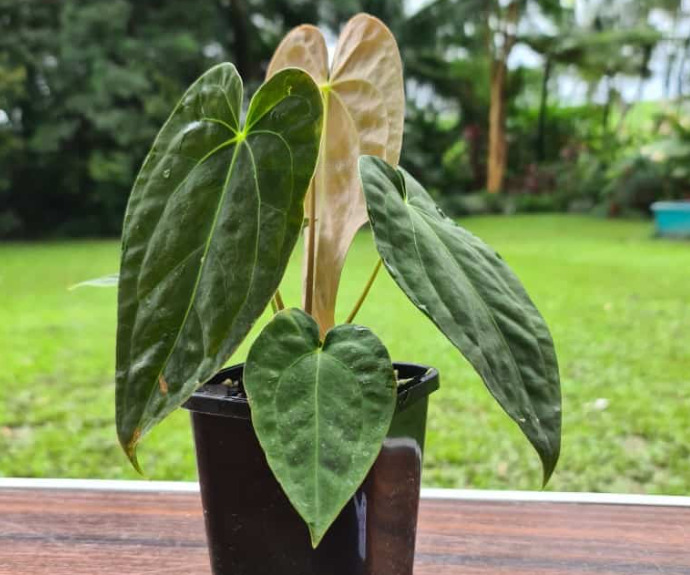
Anthurium Papillilaminum Description:
How To Care For Your Anthurium Papillilaminum?
This exotic plant, the Anthurium Papillilaminu require proper care to thrive. Here’s the step by step care guide for this tropical beauty.
1. Anthurium Papillilaminum Soil Requirements
The potting soil, which is nutrient-rich and organic, is the best option for ideal growth of anthurium papillilaminum. A well-draining soil that retains maximum moisture will remain hydrated for a long and provides ideal environment for Anthurium Papilliaminum to grow. Adding coco coir or perlite helps increase the moisture retaining capacity of the soil.
To make an ideal potting mix, you can follow this recipe:
If you want fresh anthurium papillilaminum, maintain its pH range from 5.5 to 6.5. Depending on your plant size, refresh its soil ingredients after a month or a year.
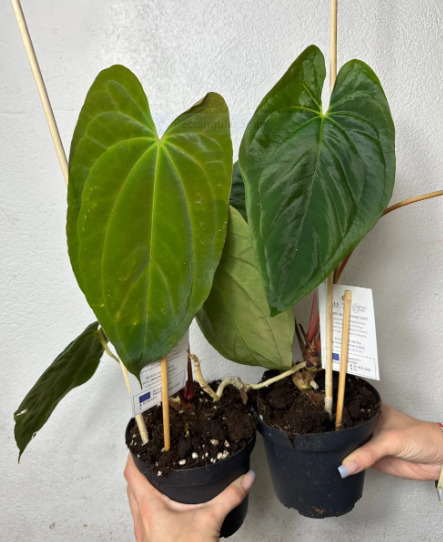
2. When to Water Your Anthurium Paplillaminum?
Water your Anthurium Papillilaminum once a week or when the upper 1-2 inches of the potting mix feel dry.
Like other anthuriums, Anthurium papillilaminum needs proper watering to stay healthy. It requires more water during summer and spring (the growing season) than during winter and autumn.
If the plant is in a warm area, you can water it two to three times a week. If the area is more relaxed, it requires less water because the soil stays moist for many days. So, watering also depends on the humidity and temperature of the place where it is growing.
Overwatering makes the soil too moist, which causes root rot. On the other hand, underwatering makes your plant leaves dry and wilted. In both conditions, your plant starts dying slowly.
Avoid using tap water for watering because it contains many harmful chemicals. Prefer rain or filtered water.
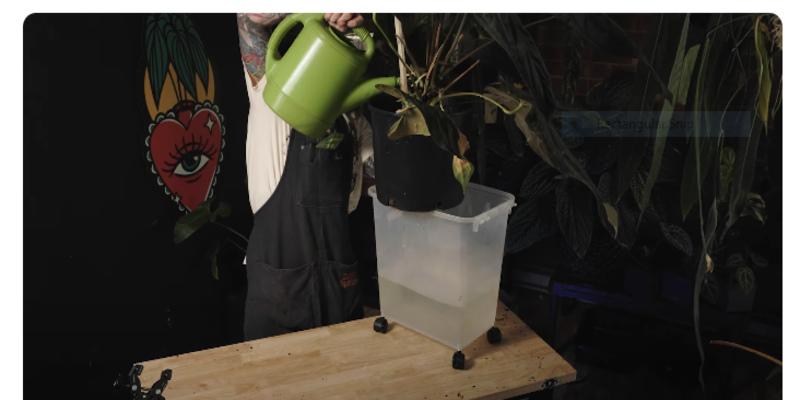
3. Anthurium Papillilaminum Lighting Requirements
Anthurium Papillilaminum loves to thrive in bright or indirect sunlight. Therefore, place your plant under a canopy or shaded area where it will receive filtered sunlight.
The best place for your houseplant is an east—or north-facing window. Avoid placing it near a west-facing window because too much direct sunlight can damage your plant’s health.
If you are facing lighting issues, use artificial light or LED lights. These can provide the light intensity necessary for your plants’ growth.
Too much exposure to sunlight can burn your plant leaves. During the dormant season, your plant needs less light to grow.
4. Anthurium Papillilaminum Temperature Requirements
Anthurium papillilaminum requires warm temperatures to thrive.
The ideal temperature for daytime is between 70 and 90 degrees Fahrenheit. At night, it should be less than 60 degrees Fahrenheit.
These plants can quickly grow in cities or countries with temperatures higher than 50 degrees, like USDA zones 11-12.
If your plant leaves turn yellow and show less growth, your plant faces the problem of low temperature. On the other hand, if the temperature rises above 95 degrees, it can cause leaf transpiration.
5. Humidity Requirements for Anthurium Papillilaminum
Humidity is another essential factor to maintain. The ideal indoor and outdoor humidity range for your Anthurium Papillilaminum is between 60% and 80%.
If humidity is low around your plants, you can use a humidifier to improve their growth. The minimum humidity level for your anthurium papillilaminum should be 40% to 60%.
Other practical alternatives to increasing humidity are regularly misting leaves and using a pebble tray filled with water.
6. When to Fertilize Your Anthurium Papillilaminum?
Fertilize your Anthurium Papillilaminum once a month during its growing season.
You can use high-quality fertilizers for pretty foliage and vibrant growth. If you want the best results:
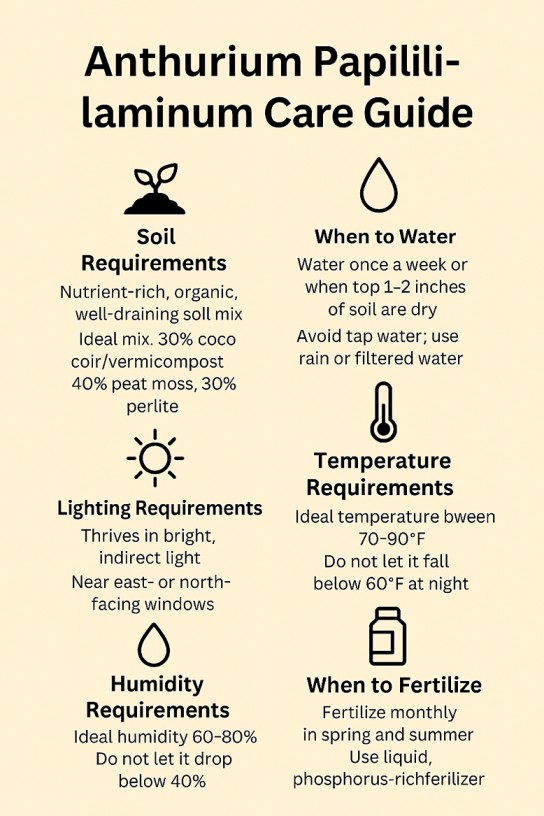
When to Repot Your Anthurium Papillilaminum?
The best time for repotting anthurium papillilaminum is when it doubles in size from the original. Shift it to a bigger pot when it is 20 inches tall in a 60cm pot. Make sure the new pot is 2 inches bigger than the older one.
Adding organic matter to the soil during repotting is a good idea. If you have yet to add it, give it some water.
If you have purchased a new plant, wait to repot it. It should settle into its new home for 3-7 days.
Generally, you can repot your Anthurium Papillilaminum every year.
Pruning Guide for Your Anthurium Papillilaminum
Pruning is essential for better plant maintenance and survival. Remove all the damaged and wilted leaves of your plant. Prune your plant with clean scissors to make it classier and healthier.
As we know, plant sap is poisonous to humans, so always wear gloves while pruning.
How to Propagate Your Anthurium Papillilaminum?
There are two methods of propagation, including root division and stem cutting, for your Anthurium Papillilaminum.
Root Division:
Root Division is an excellent propagation method for replanting your mother plant. Propagation via root division involves the following steps:
Stem Cutting Propagation:
The propagation through stem cuttings involves the following steps:
Common Problems of Anthurium Papillilaminum and Their Solutions
Anthurium Papillilaminum can face the following issues.
1. Root Rot
Root rot and yellow leaves are significant signs that your plant is experiencing overwatering.
Solution: This problem can be solved by less watering, removing damaged roots, and enhancing soil drainage.
2. Slow Growth and Wilted Foliage
Slow growth and wilted foliage or leaves indicate that your plant is facing the problem of underwatering.
Solution: Protect your plant through proper watering and keeping its soil moist.
3. Discoloration of Leaves
Discoloration of leaves and stunted growth indicate that your plant is facing the problem of nutrient deficiency.
Solution: You can replenish your plant with the help of compost or organic fertilizer.
4. Pests Attack
Chewed foliage and sticky residue indicate that your plant is facing the problem of pests.
Solution: You can protect anthurium papillilaminum by using neem oil and insecticidal soap. Check your plant health regularly.
5. Brown Leaf Tips
This happens when plant roots fail to transport water to the remaining parts. Sometimes, over- and underwatering can also be the reason.
Solution: To fix this problem, reduce watering if your plant’s foliage does not look healthy or give more water when it seems dry.
6. Leaf Spot Fungus
Your anthurium papillilaminum faces this fungal infection when you place it in high humidity or near the infected plant. In this case, brown or black round patches form on your plant leaves.
Solution: If only a few leaves are affected by this infection, cut them and treat the remaining plant with copper or benomyl. Otherwise, discarding is the best option.
Also Check What is Anthurium Crystallinum?
FAQS
What is the best spot to place your Anthurium Papillilaminum?
For indoors, place your plant near a window, where it will receive bright and filtered sunlight. For outdoors, place your plant under a canopy or shaded area.
How long does Anthurium Papillilaminum survive?
The life span of this plant mainly depends upon care and location. Many anthuriums last for years and bloom throughout the whole year, with each flower lasting 2 to 3 months.
Which fertilizer is best for Anthurium Papillilaminum?
Phosphorus-rich fertilizer is the best option because it improves your plant.
Is Anthurium papillilaminum toxic or not?
Yes, this anthurium species is also toxic. It contains calcium oxalate, which is harmful to humans and pets. Keep this plant away from your pets and children, as it can cause skin irritation.
Conclusion
Anthurium Papillilaminum, with its dark green leaves with white veins, is an excellent plant that hails from the tropical rainforests of Panama. The plant grows well in your home garden when properly cared for.
It requires well-draining potting soil with warm temperatures, regular watering, enough humidity, and bright indirect light to thrive indoors. To give it extra boost, you can fertilize it once a month during its growing season. By following these care tips, you can keep it healthy and safe from pest and disease attacks.
The classic ‘unicorn’ Anthurium Paillilaminum is a popular tropical houseplant known for its rarity and stunning foliage. The plant produces large, velvety, and heart-shaped leaves that exhibit a deep olive-green hue.
This member of Araceae family is a slow-growing species and maintains a manageable size when cultivated indoors. In this blog post, we will briefly discuss Anthurium Papillilaminum description, care requirements, propagation methods, and its common problems with troubleshooting steps.

About Author
Hi, I’m Emily Davis, a passionate tropical plant enthusiast dedicated to sharing knowledge and expertise with plant lovers. Through his blog, I will provide guides, tips, and tricks for caring for tropical houseplants species like Alocasia, Anthurium, Calathea, Philodendron, Begonia, and many more that will help readers bring a touch of paradise into their own homes. With a deep love for the vibrant colors and lush textures of tropical flora, I’m committed to inspiring others to cultivate their own tropical oasis.


